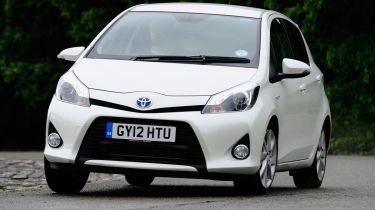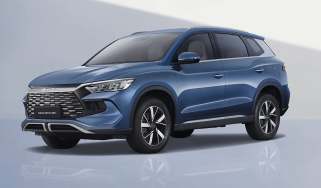Toyota Yaris Hybrid
Can styling upgrades and smart hybrid technology help the lacklustre supermini to raise its game?
Hybrid cars work best in clogged city streets, where their batteries can be used for long periods to cut emissions. So in theory, the latest Toyota to receive the hybrid treatment – the new Yaris – should be one of the brand’s most efficient models.
Not only is it the smallest production car to be fitted with a petrol-electric drivetrain, but it’s also the cheapest: prices start at £14,995.
The standard Yaris limped to a fourth-place finish when we tested it against its rivals at the end of last year. Yet the addition of a hybrid means the Toyota is now the only supermini to offer a choice of petrol, diesel and hybrid power.
However, unlike the underwhelming Auris Hybrid, the Yaris gets a full cosmetic makeover to go with its extensive mechanical changes. One of our criticisms of the standard car was its bland design, but the hybrid looks more purposeful at first glance. The front has been restyled, with a larger lower grille, teardrop-shaped foglights and a jutting bumper that adds 20mm to the car’s overall length.
Angular projector-style headlights and bright LEDs inside the front and rear clusters give the Toyota sorely needed personality, so it should be instantly recognisable on the road. Subtle badges on the wings and bootlid also alert other drivers to the fact that this is no ordinary Yaris, and the top-spec T Spirit model in our pictures gets 16-inch alloys.
Used - available now

2025 Toyota
Yaris
45,209 milesAutomaticPetrol1.5L
Cash £14,188
2025 Toyota
Yaris
58,977 milesAutomaticPetrol1.5L
Cash £13,676
2025 Toyota
Yaris
13,697 milesAutomaticPetrol1.5L
Cash £15,421
2019 Toyota
Yaris
21,928 milesAutomaticPetrol1.5L
Cash £12,908Style-conscious buyers should avoid the entry-level T3, as it makes do with steel wheels plus black plastic mirrors and door handles.Inside, the changes continue thanks to more special trim brought in from across Toyota’s hybrid range. The rev counter has been swapped for a power gauge that shows the status of the on-board batteries as you drive, while the dials are picked out in silver and blue. Gadgets like the Toyota Touch audio screen, DAB, Bluetooth and a reversing camera are all included on the T4, but sat-nav costs £650 extra. That’s £250 more than a similar set-up in the Peugeot.
Some of the standard car’s strengths, such as great visibility and a tall driving position, remain, but its weaknesses have been carried over, too. Build quality is fairly robust, yet the Yaris features some of the hardest plastics we’ve seen in a supermini, so it feels cheap inside. Classy items like the chunky steering wheel and elegant gearlever look all the more out of place thanks to the uninspiring dash.
At least practicality hasn’t suffered in the transition to hybrid. The nickel-metal-hydride batteries from the Auris have been shrunk by 20 per cent to make them small enough to fit under the rear seats. This means the Yaris’ boot can carry exactly the same 286 litres as before, increasing to 768 litres with the seats folded. So it has a slight advantage over the 208, but there is a penalty to pay. Putting the fuel tank and battery pack under the rear seats sounds good in theory, but it creates a bulge that intrudes into the footwells and impedes legroom for passengers in the back.
Yet this minor inconvenience is much less important than how the Yaris Hybrid drives. There’s only one engine option: a 1.5-litre petrol based on the 1.8-litre from the Prius. On its own, it produces a modest 73bhp, but it combines with the electric motor to muster a decent total of 98bhp and 111Nm of torque. Nonetheless, most buyers should be aiming to keep the engine switched off for as long as possible. This happens in two ways: by pushing the EV mode button on the centre console, or by leaving the car in Drive and letting it decide itself when is best to use petrol or electric power.
Depending on the level of battery charge remaining, the Yaris can travel up to 1.2 miles in zero-emission mode. That may not sound like much, but Toyota reckons that nearly 60 per cent of the average commute will be spent in electric mode when the car is left to its own devices. This contributes to class-leading CO2 emissions of only 79g/km and an impressive claimed fuel economy figure of 80.7mpg.
Yet in practice, it’s difficult to stop the engine cutting in. Prod the throttle too hard and the 1.5-litre petrol starts up. Because it has to be revved to make decent progress, it sounds noisier than the Peugeot’s on the move. The CVT gearbox holds the engine revs uncomfortably high when accelerating quickly, meaning you end up driving as gently as possible in an effort to keep the noise down. This works around town, but on faster roads or when climbing hills, the Yaris can feel thrashy and underpowered.
At the track, it matched the 208’s times with the gearbox in kickdown mode, but these results aren’t an accurate reflection of the Toyota’s thrashy real-world performance. In town, a tight turning circle and very light steering make the car easy to drive, but they also mean it lacks any dynamic sparkle. It runs out of grip quickly through corners and offers little feedback to the driver.
The suspension has been softened to cope with the extra weight. This has increased body roll, yet hasn’t taken the edge off the standard Yaris’ firm ride and the car still jolts over big bumps. This may not matter to some, though: Toyota’s consistently strong showings in our Driver Power survey, five-year warranty and strong residuals will appeal to private buyers. So the Yaris Hybrid works well in the right environment, but will the 208 diesel prove to be the more convincing all-rounder?
Details
Chart position: 2Why? With revised styling, a smart interior and the promise of class-leading efficiency, the Yaris Hybrid could be the pick of the range – despite its high asking price.



